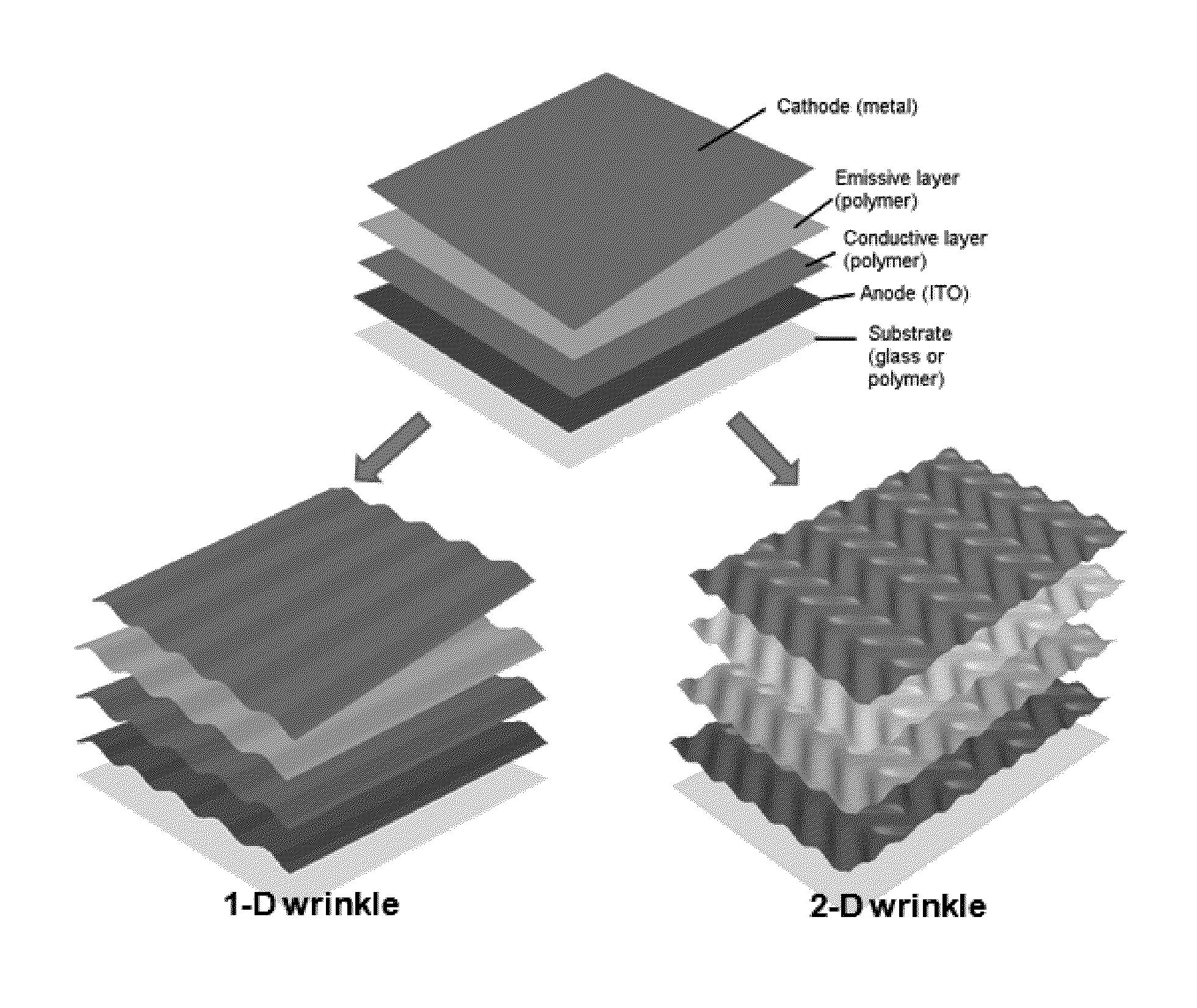Thin Films with Micro-Topologies Prepared by Sequential Wrinkling
a technology of microtopologies and thin films, applied in the directions of film/foil adhesives, tubular fabrics, transportation and packaging, etc., can solve the problem of challenging prediction design of ordered topologies
- Summary
- Abstract
- Description
- Claims
- Application Information
AI Technical Summary
Benefits of technology
Problems solved by technology
Method used
Image
Examples
example 1
Preparation of PDMS Sheet
[0196]PDMS preparation was done using the Sylgard® 184 Silicone Elastomer Kit from Dow Corning. The elastomer and curing agent were thoroughly mixed at a mass ratio of 10:1 and poured into petri dishes with a PDMS layer of about 2 mm. The petri dishes were put in a dessicator to degas for 45 minutes and then cured in an oven at 70° C. for one hour. Cross-shaped PDMS films 6-cm long and 2-mm thick were cut using Epilog® laser cutter for the experiments. The samples were placed in a home-made sample holder for biaxial stretching. Legs of the PDMS were introduced between jaws and through the use of screws stretched to a specific elongation.
example 2
iCVD Deposition of Polymer Coating
[0197]A layer of trichlorovinylsilane (97%, Sigma) was used as adhesion promoter between PDMS and p(EGDA). First, a plasma oxygen treatment for PDMS surface activation was carried out in a plasma cleaner (Harrick Scientific PDC-32G) at 18 W for 30 s. Immediately, the biaxially stretched cross-shaped PDMS film was introduced in an oven at 40° C. under vacuum and exposed to trichlorovinylsilane vapours for 5 minutes.
[0198]iCVD polymerizations were conducted in a custom-built cylindrical reactor (diameter 24.6 cm and height 3.8 cm). EGDA (98%, PolySciences) was heated to 60° C. and was introduced into the reactor at a flow rate of 0.5 sccm by using regulated needle valves. Tert-butyl peroxide (TBPO) (98%, Aldrich) and nitrogen were fed into the chamber at a flow rate of 1.5 sccm and 1.0 sccm respectively through a mass flow controller (MKS Instruments). ChromAlloy O filaments (Goodfellow) were resistively heated to 260° C. The distance between the fila...
example 3
Characterization of Mechanical Property of p(EGDA) Coating
[0199]In order to test the material properties, self-free-standing films of p(EGDA) were obtained through two steps: first, the films with certain thickness were deposited on a sacrificial layer; second, a self-free-standing film was obtained by dissolving the sacrificial layer in the deionized water. Films with 3.5 μm thickness were chosen since the films must be thick enough to be self-standing. Since those samples were very thin and brittle, a cardboard frame was used to handle them: the frame was first glued to the sample before dissolving the sacrificial layer in water. Then the cardboard frame was cut just before the test once both ends of the samples were amounted in the jaws of the Q800 DMA. 1% / min strain rate ramps were performed on EGDA films at room temperature. The measured stiffness of the p(EGDA) film is 775 MPa.
PUM
 Login to View More
Login to View More Abstract
Description
Claims
Application Information
 Login to View More
Login to View More - R&D
- Intellectual Property
- Life Sciences
- Materials
- Tech Scout
- Unparalleled Data Quality
- Higher Quality Content
- 60% Fewer Hallucinations
Browse by: Latest US Patents, China's latest patents, Technical Efficacy Thesaurus, Application Domain, Technology Topic, Popular Technical Reports.
© 2025 PatSnap. All rights reserved.Legal|Privacy policy|Modern Slavery Act Transparency Statement|Sitemap|About US| Contact US: help@patsnap.com



